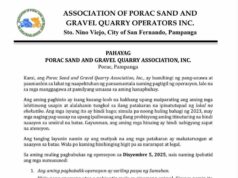Award-winning writer Robby Tantingco, director of the Center for Kapampangan Studies of the Holy Angel University in Angeles City, has come out with a list of Holy Week events, mostly on Good Friday, that “avoid the madding crowd” in bloody crucifixion sites.
Noting that “all roads will surely lead to Cutud” especially on Good Friday, Tantingco suggested that “for a change, why not avoid the madding crowd, take the road less travelled, and discover little-known Holy Week events in Pampanga.”
He listed seven alternatives for pilgrims and tourists.
Tantingo cited “pasyon serenata” on Holy Wednesday evening in Barangay San Basilio in Sta. Rita town.
“It’s a showdown between two brass bands and their respective choirs who try to outperform each other by chanting the pasyon to the tune of classical operas. They play all night long, one page at a time, until they finish the whole book. The sight and sound of betel-chewing barrio folk singing the entire history of salvation in Kapampangan and to the tune of Verdi and Puccini will blow you away. Despite their ‘guegue’ it’s a performance worthy of a concert hall instead of some dusty road in a remote farming village,” he said.
Then there’s the “grand assembly of penitents” in Mabalacat City early morning on Good Friday.
“It’s a scene straight out of a Cecil B. DeMille movie: hundreds, maybe thousands, of half-naked flagellants and cross-bearers in flowing red robes, brought together by sin and tradition, converge in the church patio for an orgy of suffering, self-mutilation and penance. The number of penitents makes you wonder if fl agellation, like circumcision, is a rite of passage among boys in Pampanga,” he said.
Tantingco also cited the “cenaculos of Barangay Pampang in Angeles City late morning of Good Friday.
“Here, there are at least two passion plays, performed by actors from the vicinity of the public market: one at Barangay Lourdes Northwest which culminates in a live crucifixion watched by hundreds if not thousands, and a smaller, less-known version, at Area, in Barangay. Sta. Teresita, the place once known for its brothels — which give the reenactment another layer of meaning and significance, especially since the Christ-figure is savagely mauled and is rescued by weeping women,” he noted.
Tantingco also noted that on Maundy Thursday and Good Friday, even transvestites could be seen bearing heavy crosses. He said they are among “penitents all over Pampanga, but it takes luck to catch them.”
They also include “cross-bearers who carry electric posts and huge banana trunks seen in Barangay San Agustin in Magalang, the women cross-bearers, the transvestite cross-bearers, the cross-bearers who tie a samurai around their waist with the tip pressed against their chin to keep their heads up, and the cross-bearers who are tied together to the same cross so that they can take turns carrying it, seen in Dau, Mabalacat.”
“In Barangay Lourdes Northwest, Angeles City I saw a cancer-stricken mother carrying a cross while her entire family prayed the rosary and followed her around. And then there are the dreadful ‘magsalibatbat’ who crawl on the road for miles, rubbing their skin continuously against the concrete until they’re all bruised and covered with dirt,” he noted.
In Guagua town also on Good Friday, there’s the “tanggal” tradition. “This is the ritual where a life-size statue of Jesus with moveable neck and joints is taken down from the cross and laid down and dressed up to become the Santo Entierro (The Interred Christ).”
“In the past, parish workers closed all church doors and windows and banged metal to simulate the eclipse and the thunderclaps that supposedly accompanied the Crucifixion, and to arouse the same fear and awe experienced by the Jews. Today, we just rely on the rhetoric and theatrics of the Sieta Palabras speakers,” Tantingco said.
He said that on Good Friday, “the entire province quiets down as night falls on Good Friday, when parishes hold hushed processions of their heirloom santos, led by the Santo Entierro and the Mater Dolorosa.”
Tantingco said “they’re all happening simultaneously: the candlelit carrozas of Arayat which transport you back in time, the sweet sound of violins playing Stabat Mater in San Fernando (added attraction: rose petals thrown from the balcony of the Rodriguez Mansion), the pomp, pageantry and piety of Sta. Rita reminiscent of Lino Brocka’s Tinimbang ka Ngunit Kulang, the breathtaking beauty of the Mater Dolorosa of Guagua, and the grandeur of the Santo Entierro of Sasmuan.”
“But if you have to attend only one, make it Bacolor, the colonial capital of the province, whose old families, driven away by the lahars of the 1990s, make a sentimental journey back home to accompany their respective paso (float). Tradition dictates that they wear black, cover their heads with pointed hoods, hold icons of the crucifixion and walk barefoot (probably a legacy from ancestors in Seville, Spain). The antiquity and craftsmanship alone of the santos and their silver-plated carrozas will make your jaw drop,” he said.
Finally, Tantingco cited the “unusual Biernes Santo procession” of Sasmuan town on Good Friday.
“It’s unusual because the grim procession of the dead Jesus and His grieving Mother is followed by a grimmer procession of ‘magdarame’ or flagellants and cross-bearers,” he said.
“This is Pampanga, where church piety collides with folk defiance, where the holiest days of the year are celebrated in the unholiest manner, where the charming and solemn rites of the Church coexist with the raw, bloody, but ultimately more exuberant rituals of the common folk,” he added.




